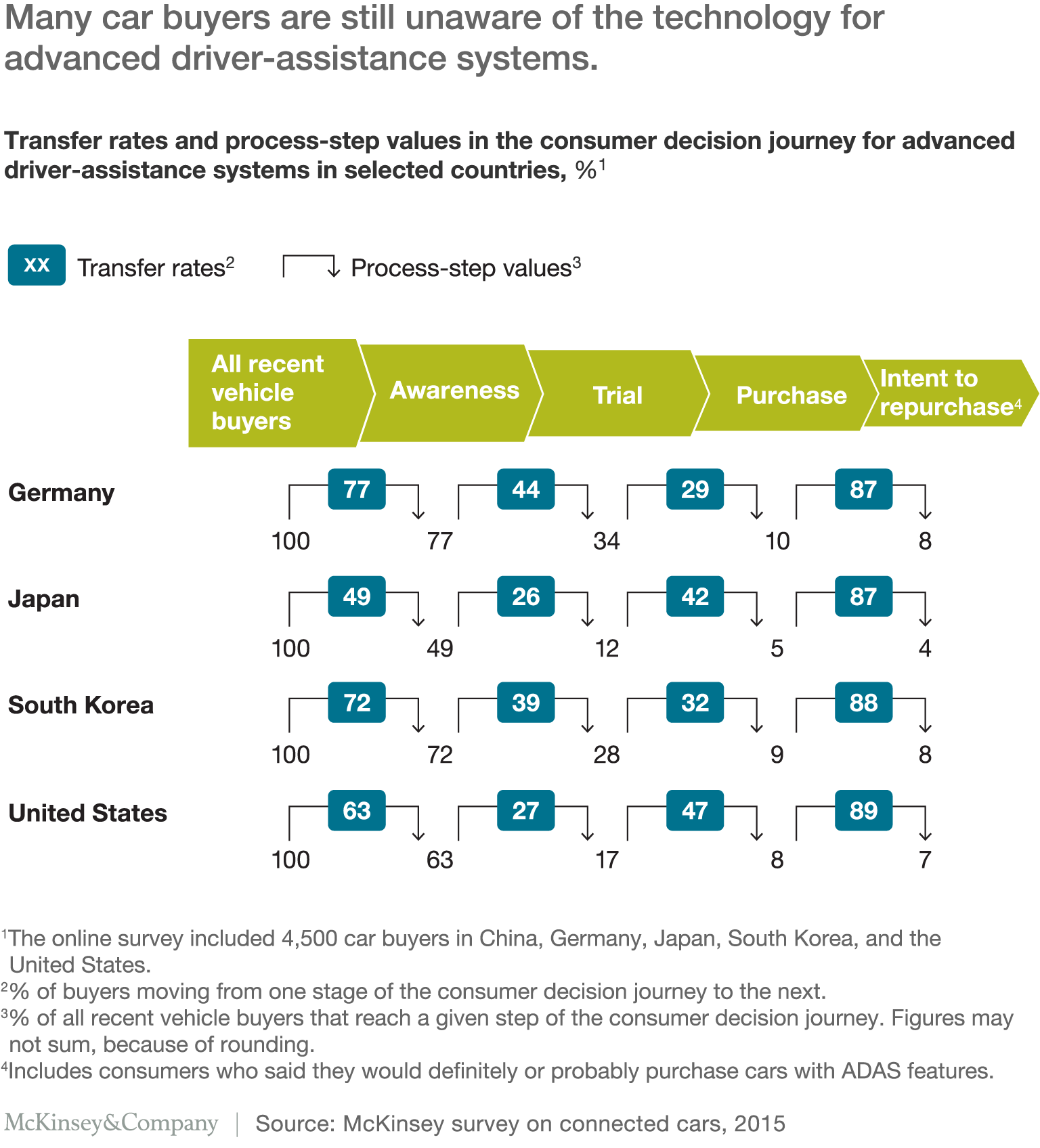The Fight For Safety
I’m looking at safety in the automotive sector and giving my thoughts on how it could be improved.
The Accepted Road Toll
1.25 million people are killed on the road each year in the world. With over 100 people dying in a motor vehicle crash per day in the US alone, it is the equivalent of a Boeing 737 falling from the sky every single day. This analogy is incredibly striking. The media coverage is nearly nonexistent.
The acceptance we have towards road death remains inexplicable to me.
The solution❓
ADAS (Advanced Driver Assistance Systems).
An ADAS is a system embedded in a vehicle which provides functionalities to increase overall road safety. Crash avoidance, crash severity mitigation and protection and post-crash phases are the main purposes of ADAS.
The Slow Adoption of ADAS
Advanced Driver Assistance Systems (ADAS) are gradually increasing the safety in our cars but their adoption is rather slow. Let’s first look into why. This McKinsey study provides some insights.

The first observation is that generally, people have a low awareness that these systems even exist. Advertisement seems insufficient.
This fact might also be due to the naming confusion. This website lists the different names the same system can have for different car manufacturers. Let’s take an example: The Autonomous Emergency Braking (AEB) functionality warns the driver about an abrupt deceleration of the car ahead which might result in a collision and ultimately takes action autonomously to apply the brakes if the driver does not respond at all or quick enough. Here are a few examples of names some car manufacturers are using to brand their system:
- Audi: Pre Sense Plus
- BMW: Driving Assistant Plus
- Ford: Active City Stop
- Honda: Collision Mitigation Braking System
- Mercedes-Benz: PRE-SAFE Brake
- Volkswagen: City Emergency Braking
- Nissan: Intelligent Emergency Braking with Forward-Collision Warning
(Nissan’s designation is not easy to remember but give a better sense of what it does…)
I understand very well that each of these systems has a different implementation by the OEM or their Tier1/2 supplier which result in different sensitivity and user experience but they should all generally behave in the same way.
Far from me the wish to commoditize each ADAS where I think lies a great differentiating factor for companies but there should be some form of standardization in the naming convention.
For the average customer whose only knowledge about cars is knowing where the gas pedal is, grasping what is “Driving Assistant Plus” or “PRE-SAFE Brake” is supposed to perform might be a tough one. In the end, the choice might be none and a degraded overall safety of the purchased vehicle. A shame since the vast majority of people is convinced once they’ve tried an ADAS once: almost 90% in the US.
Some proper education needs to happen.
Mandating ADAS
The responsibility to spread ADAS across the auto market does not entirely fall onto the OEMs. In the EU, the European Commission (EC) has the ability to mandate the fitting of any particular ADAS on motorised vehicles.
As far as I’m aware, the only 2 mandatory fitting of ADAS in the EU are the following:
- Electronic Stability Control (ESC) Systems on all vehicles (from 1 Nov 2011 for new types of vehicle and 1 Nov 2014 for all new vehicles)
- Autonomous Emergency Braking (AEB) and Lane Departure Warning (LDW) Systems on heavy-duty vehicles (from 1 Nov 2013 for new types of vehicle and 1 Nov 2015 for all new vehicles)
I believe that the approach is too slow. We have so much technology already available to reduce significantly the number of deaths on the road. Here is a non-exhaustive list of safety systems which I believe should already be mandatory on all new models. Throughout the rest of the article, I’ll often be referring to this report from the European Road Safety Observatory (ERSO) released in 2016.
Seat Belt Interlocks
I’ll start with the simplest one. Seat Belt Interlocks prevents the car from starting if all the occupants do not have their seat belt fasten. Once the car started, if a passenger unfastens his/her seat belt, the system will behave as a Seat Belt Reminder and emit an audible reminder.
The injury reduction effectiveness of seat belt was reported to be about 50% in this study where at the same time about 50% of fatally injured drivers are not wearing a seatbelt.
The cost-benefit ratio of mandating the fitting of Seat Belt Interlocks on all new vehicles is roughly 100:1 since the technology is ready and cheap.
In reality, what I’m asking here has already been done. In the US, in 1974. It was too soon and poorly executed. Today is the time.
Autonomous Emergency Braking (AEB)
A study from Cicchino J. in 2016 shows that AEB reduces rear-end striking crash involvements rates by 50%.
After being mandated onto heavy-duty vehicles in the EU, I believe that the technology had time to mature. AEB has the potential to prevents, in my opinion, a staggering amount of fatal and non-fatal accident due to distracted drivers.
Lane Departure Warning (LDW)
This camera-based system warns the driver when a lane line is unintentionally crossed or about to be crossed. The feedback can be of multiple forms:
- Haptic feedback: a small amplitude high-frequency oscillation is applied to the steering wheel.
- Visual feedback: Blinking lights on the dashboard or in the Head-Up Display (HUD).
- Audible feedback.
Whenever the onboard camera responsible for that function detects that the car is about to cross a line without having the correct direction indicator enabled, the warning is triggered.
Without having the possibility to disable the system and the correct choice of (annoying) feedback from the car manufacturer, eventually, the driver should prefer to use the direction indicator instead of being lectured by the car over and over again.
Every driver experience skill atrophy over the years. I believe that such a system could continuously teach the driver or at least maintain his/her current level of skills.
Driver Monitoring System (DMS)
With the rise of better infotainment systems and wider screens in our latest cars as well as our constant need to check our smartphones, drivers have more and longer inattentiveness periods behind the steering wheel. Each time we take our eyes off the road, we might run over a cyclist, a pedestrian, crash into another car… This behaviour is not acceptable and the car should prevent us from doing so.
A Driver Monitoring System can detect in which direction the driver is looking and can correlate that with the current speed of the car and the upcoming road trajectory to determine if the driver is focused or not. Drowsiness can also be detected by such a system and a request to stop the car and take a break could be emitted. Finally, some advanced system can evaluate the cognitive load/distraction of the driver. This page provides more information regarding how such a system works.
In this article Jennifer Smith, who lost her mum to a distracted driver, says “We all know what’s going on, but we don’t have a breathalyzer for a phone.”.
Actually, we do.
Have a look at the Car Glance Classification system Lex Fridman built at MIT as part of his class entitled Deep Learning for Self-Driving Cars.
Note: This is a custom-made retro-fitted system. It does not exist in any commercially available Tesla models.
The system described in the video detects where the driver is looking. From the date of the video, this quite mature system was already available in August 2016. It seems obvious to me that in the case where the driver is lacking attention such a system coupled with a disincentivizing haptic feedback in the steering wheel, audible warnings, as well as visual cues, would rapidly bring back his/her focus on the road ahead.
The most compelling argument for incorporating this type of system in our cars is that, again, it continuously teaches the driver how to drive in a safe manner.
Finally, after watching this film From One Second To The Next from Werner Herzog, don’t you think that these fatalities could not have been avoided using a Driver Monitoring System?
The National Highway Traffic Safety Administration (NHTSA) estimated that over 10% of road fatalities in the US in 2016 are associated with distracted drivers.
Intelligent Speed Assistance (ISA)
From ERSO’s report:
ISA is a system which informs, warns and discourages the driver to exceed the statutory local speed limit or other desired speed thresholds below this limit at safety-critical points.
Here is a video to explain how Ford chose to implement it on the S-MAX:
The effectiveness of ISA has demonstrated by several studies such as the one conducted by PROSPER.
These results show that ISA could reduce fatalities by half.
The financial incentive is also very strong since the benefit to cost ratio of mandating ISA on all new cars is around 4. All add up to make a very compelling case for ISA.
Finally, the real difficulty in deploying ISA is the human-machine interface. The system needs to find the right balance between too much intervention which might result in a general disapproval from the public and a major set back for the OEM and his brand and too little intervention which would have no effect on safety.
Include data from https://www.youtube.com/watch?v=SoZLrZTnUGs
Alcohol Interlock System
I kept this one for the end because the technology is not there yet but is very promising.
Such as speeding, drunk driving is responsible for about another third of road fatalities.
Nobody should have the right to drive drunk because in most cases, the victim is not the drunk driver. The victim is a pedestrian, a cyclist or another driver.
To prevent driving under the influence, the Driver Alcohol Detection System for Safety (DADSS) is working on non-obtrusive methods. The one I prefer is the touch-based system where the alcohol level would be measured using an infrared light sensor when the driver touches the start button.
This method would remove the need to blow into the interlock device and wait about a minute to have permission to turn on the car. It goes without saying that method (only used as after-market device for recidivist drunk drivers) is a no-go.
The Self-Driving Cars of Tomorrow?
Am I losing my time trying to fit ADAS into our cars when we’ll have self-driving cars tomorrow?
I am not. Self-Driving Cars are the future and they will arrive … in the future.
The roads will be shared between human-driven vehicles and autonomous vehicles for another 50 years minimum.
Previsions forecast 1 billion vehicles on the roads by 2030 and most of them will be human-driven and built in the next couple of years. In the future, Self-Driving Cars will provide significantly increased safety in their segment of the market but if we want safer roads overall we need to act now and start mandating well designed ADAS solutions on all our human-driven cars.
Sources:


